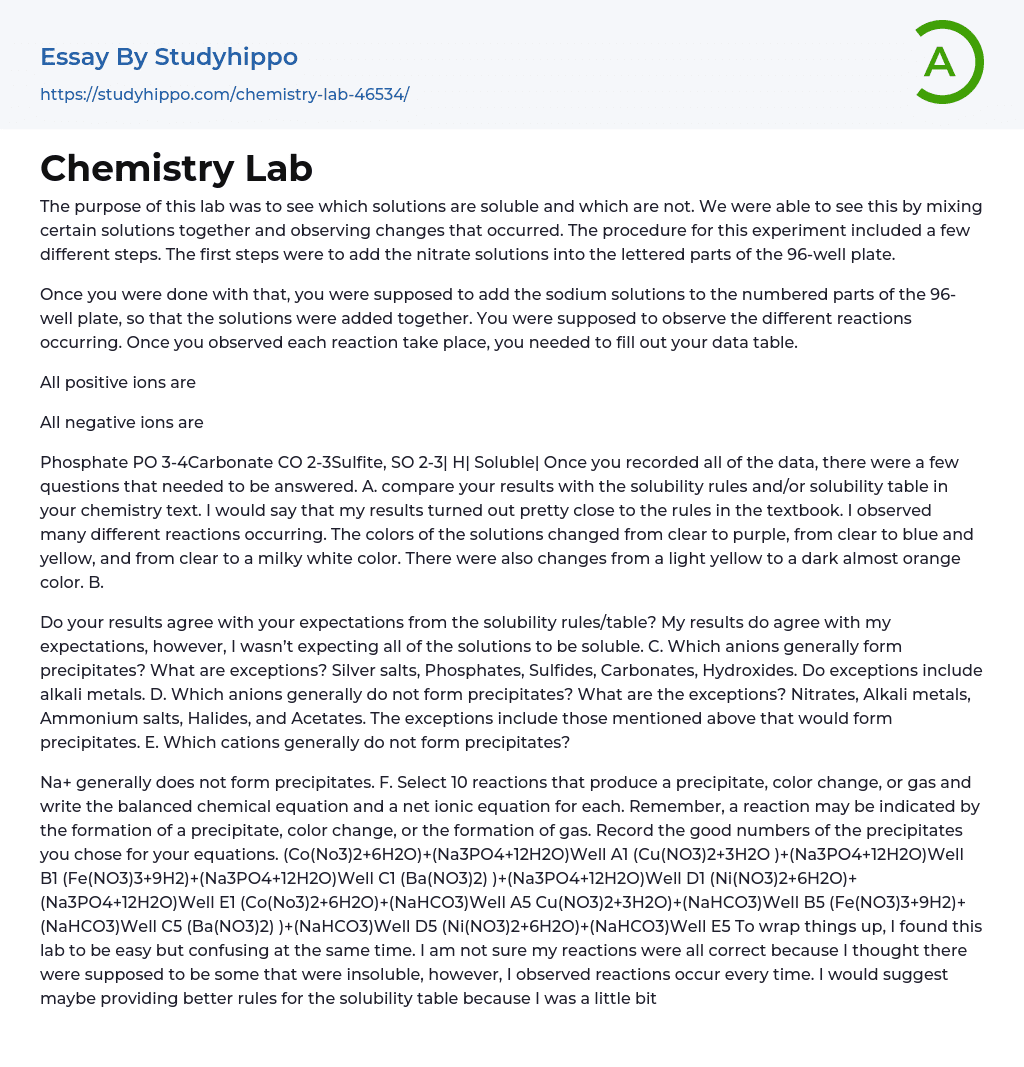The objective of this lab was to determine the solubility of different solutions through a series of mixing and observation steps.
The initial steps consisted of pouring the nitrate solutions into the designated sections of the 96-well plate. After completing this task, the sodium solutions were to be added to the specified sections of the 96-well plate in order to combine the solutions. The subsequent step was to observe the various reactions taking place. Each reaction was to be carefully noted in the data table. The positive ions are represented by Phosphate (PO3-4), Carbonate (CO2-3), and Sulfite (SO2-3). The negative ions are indicated by "H" and are soluble. Once all data had been recorded, several questions needed to be addressed.
When comparing your results, refer to the solubility rules and/or solubility table in your chemistry text. In my case, I found that my
...observations aligned fairly well with the rules mentioned in the textbook, as I witnessed several distinct reactions taking place.
The solutions underwent different color changes, ranging from purple, blue, yellow, to milky white. Furthermore, there was a shift from light yellow to a shade resembling orange. The obtained results are consistent with the expected outcomes, although not all solutions were predicted to be soluble. In general, anions like silver salts, phosphates, sulfides, carbonates and hydroxides have a tendency to form precipitates. However, there could be instances where this pattern does not apply.
There are several anions that usually do not create precipitates, such as nitrates, alkali metals, ammonium salts, halides, and acetates. These exceptions were previously mentioned and would typically cause the formation of precipitates. However, it is worth noting that Na+ is a cation tha
generally does not form precipitates.
Choose 10 reactions that result in a precipitate, color change, or gas formation. Write the balanced chemical equation and net ionic equation for each reaction. Keep track of the corresponding precipitate numbers for your equations.
(Co(No3)2+6H2O)+(Na3PO4+12H2O)Well A1
(Cu(NO3)2+3H
- John Locke essays
- 9/11 essays
- A Good Teacher essays
- A Healthy Diet essays
- A Modest Proposal essays
- A&P essays
- Academic Achievement essays
- Achievement essays
- Achieving goals essays
- Admission essays
- Advantages And Disadvantages Of Internet essays
- Alcoholic drinks essays
- Ammonia essays
- Analytical essays
- Ancient Olympic Games essays
- APA essays
- Arabian Peninsula essays
- Argument essays
- Argumentative essays
- Art essays
- Atlantic Ocean essays
- Auto-ethnography essays
- Autobiography essays
- Ballad essays
- Batman essays
- Binge Eating essays
- Black Power Movement essays
- Blogger essays
- Body Mass Index essays
- Book I Want a Wife essays
- Boycott essays
- Breastfeeding essays
- Bulimia Nervosa essays
- Business essays
- Business Process essays
- Canterbury essays
- Carbonate essays
- Catalina de Erauso essays
- Cause and Effect essays
- Cesar Chavez essays
- Character Analysis essays
- Chemical Compound essays
- Chemical Element essays
- Chemical Substance essays
- Cherokee essays
- Cherry essays
- Childhood Obesity essays
- Chlorine essays
- Classification essays
- Cognitive Science essays




